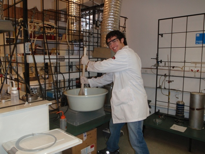
University:
Major:
Site Abroad:
Mentor(s):
Faculty Sponsor(s):
Project Title:
Project Description:
Hospital acquired infections are currently a serious problem in the industrialized world. Many deaths result every year from diseases acquired in hospitals, many of which are easily preventable. One promising solution to this problem is the use of antimicrobial materials, specifically copper-infused surfaces. Copper has been found to be highly antimicrobial in many tests. Many varieties of bacteria, including E. coli, MRSA, C. jejuni and S. enterica are susceptible to degradation by copper. The goal of this project was to take advantage of Copper´s antimicrobial properties and incorporate the Cu into polymer materials. Several types of Copper Sulfide nanoparticles were synthesized, from short rods to long wires, and incorporated into polypropylene composites to test the antimicrobial activities of each. Both the short and the long fibers were made by mixing different concentrations of CuCl2 and thiourea, the lowest concentrations of which yielded the longest rods. Different weight loadings of the CuS were mixed with the polypropylene to determine the antimicrobial efficiencies of each individual composite. The presence of Cu(II) ions were first tested for using a UV/Vis. Spectrometer. The antimicrobial capabilities of the composites were tested using the bacteria E. Coli, with all of the composites exhibiting promising antimicrobial activity. The highest weight loads (20%) of both the short and long CuS nanoparticles effectively killed all the bacteria present within 2 hours. These composites appear to be very feasible solutions to eliminating bacteria and other pathogens from surfaces. Future areas of research include using other types of nanoparticles in the composites, such as nanospheres, and determining the antimicrobial activity against a wide range of pathogens.
